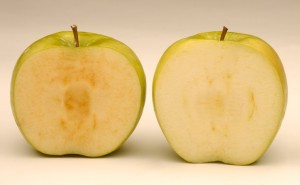By: John Frelka
GMOs, or genetically modified organisms, have long been villainized by those in certain so-called “healthy eating” circles typically including followers of Dr. Oz and/or the Food Babe. But are GMOs truly as harmful as they are touted in the media?
One of the major drivers of markets, and regulations on those markets, is the consumer. A recent study performed by the Oklahoma State University Department of Agricultural Economics showed that about 80% of respondents support mandatory labelling of foods containing DNA. Curiously, a similar number of respondents (82%) supported mandatory labelling on GMOs. This coincidence implies that consumers are not clear on what exactly “GMO” means let alone the potential impacts of GMO products on health, the environment, or the economy. All foods from a biological source (fruits, vegetables, etc.) contain DNA, regardless of if they are genetically modified or not. So, what exactly are GMOs? How are they created? In the first installment of The Dish, I ask some experts in the field these very questions.
Origins and Advances

Selective breeding has resulted in the exposed corn kernels we are used to (right) from the small grass seed pods of the original teosinte (left). (Source: Gewin, 2003)
Before GMOs were ever on the minds of scientists and consumers, selective breeding was used to create plants and animals optimized for use as food sources. This was done by choosing individuals with desired traits: cattle that grow more muscle for meat or wheat that can grow in a drought, for instance, and breeding them to create a new generation with these desired traits. In fact, the corn we are used to seeing today is the result of selective breeding and hybridization (crossing of two related species) and does not resemble the wild grass from which it originated. Unknown to our plant and animal domesticating forefathers, this selection was possible due to genetics and the transmission of DNA from the parent to its offspring.
As the understanding of genetics advanced, so did the opportunity for technological applications of this knowledge. Transfer of genes between organisms is most common among bacteria. Bacteria can exchange genes through different mechanisms such as exchange of genetic material from one cell to another (conjugation), transmission of genetic material through a virus (transduction) or just by taking up free genetic material from the environment (transformation). This phenomenon has aided in the advancement of human health in numerous ways. For instance, insulin, a hormone which plays a key role in metabolism, is critical in the treatment of diabetes. Many diabetes patients have benefited from injections of insulin made by microbes that have been modified to artificially produce it. This type of genetic engineering has been used to create vaccines, antibodies, and other beneficial drugs (Avise, 2004)
Modern Modifications

Arctic apples were recently deemed safe by the FDA. Arctic apples (right) have lowered expression of the gene for polyphenol oxidase (PPO) which causes conventional apples to turn brown (left). (Source: www.arcticapples.com)
To gain more insight into the production of genetically modified foodstuffs, I asked Dr. Kevin Folta, professor and chair of the Horticultural Sciences Department at the University of Florida, about how and why genetic engineering is being used for food production. The first thing I wanted to know is how the genes are selected for creation of a GMO. Dr. Folta tells me that the genes were originally chosen to solve a problem particularly related to crop production such as insect resistance. “These were well-characterized bacterial genes where their function and safety were well established,” he points out. More recently, other traits have been implemented by genetic engineering such as stopping browning in apples and potatoes. This was done by modifying these crops to turn off the genes responsible for this process using DNA sequences from the plants themselves. Other traits can be modified to increase nutrition (such as increase Vitamin A in rice, cassava, and bananas) or increase resistance to drought, flooding, cold or heat. “The future will move more into these areas to fortify food,” says Dr. Folta. “The main idea is to be able to grow more with less.”
Clean Cut
So, how does genetic engineering differ from the selective breeding programs of yore? “It differs in the precision,” says Dr. Folta. “In traditional breeding we are mixing many genes together, in ways we usually don’t understand. We usually don’t move a gene, we move a trait, which could be controlled by many genes.” According to Dr. Folta, this means that in breeding, we are selecting for a specific trait (fruit size, disease resistance, etc.) but in doing so we are also unintentionally selecting for other genes associated with these traits that may not be immediately evident and may actually be detrimental to the health of the organism. Genetic engineering allows for the insertion of a specific gene sequence which encodes a specific protein to introduce the desired trait without the genetic mixing of traditional breeding.
Genetically Modified Groceries
With all the outrage and negative press that GMO crops seem to be getting these days, one might suspect that everything we consume is genetically modified unless explicitly stated otherwise. However, Dr. Folta pointed out that there are currently only 8 commercially grown GMO crops that one might encounter – corn, cotton, alfalfa, soy, sugar beets, canola, Hawaiian papaya and some squash. Even as such, the products made from GM plants are chemically identical to their conventional counterparts. “Sugar from a GM sugar beet is the same as a non-GM sugar beet. Oil from soybeans is the same, GM or not. It is the plant itself that has the DNA and proteins to help the plant grow.”

(source: www.flickr.com)
When I asked Dr. Folta if there was anything else he wanted the public to know about the production of GMOs he had this to say: “I defer to the world’s most astute scientific organizations which all present a version of the following statement: ‘Transgenic crops pose no more risk than traditionally bred crops.’ That is important because it recognizes that even traditional breeding carries risk. There is nothing 100% without risk. The advantage of transgenic technology is that risk can be assessed before plant development, as well as during and after. This ensures a low likelihood of any negative health or environmental effects. Such low-risk is reflected in the perfect safety record, along with minimal environmental consequences relative to non-GM production.”
I hope I have provided a good basis for a better understanding of genetic modification and its role in food production. This is only Part 1 of a series of posts on GMO foods. Keep a look out for my next post which will focus more on a concept Dr. Folta touched on: safety of GMO food products.
References:
- Gewin V (2003) Genetically Modified Corn— Environmental Benefits and Risks. PLoS Biol. 1:8.
- Avise, J.C. (2004). The hope, hype & reality of genetic engineering: remarkable stories from agriculture, industry, medicine, and the environment. Oxford University Press US. p. 22.
John Frelka is a doctoral student in food science and technology at The Ohio State University and earned his master’s degree in food science from the University of California-Davis. Keep up with John at his blog: madfoodscience.wordpress.com.






This is a very well written article with very valid points. The world will be fed on GMOs and I have no doubt of this. However, you failed to address the biggest concern anyone with any scientific background has with GMOs.
Does genetically modifying our food crops result in a reduced need for chemical pesticides and herbicides or enable corporations to use more of them to boost their yields? There’s a lot of evidence of the later. http://www.huffingtonpost.com/2012/10/04/pesticides-gmo-monsanto-roundup-resistance_n_1936598.html